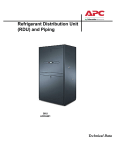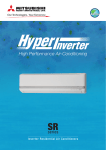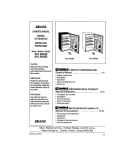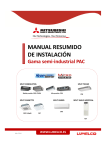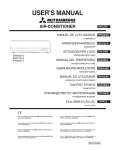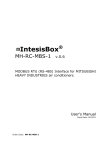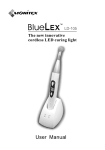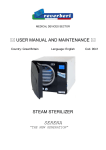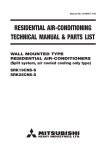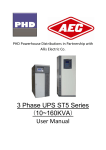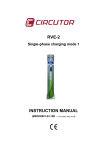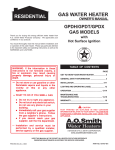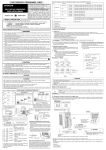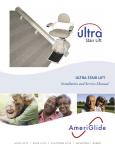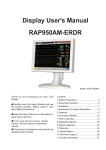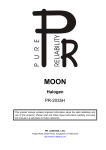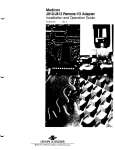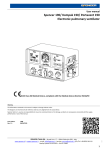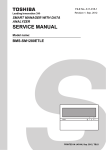Download INSTALLATION MANUAL FOR INDOOR UNIT
Transcript
(c) Model SRK71ZK-S WALL TYPE AIR CONDITIONER R410A REFRIGERANT USED RKW012A400A INSTALLATION MANUAL FOR INDOOR UNIT • This installation manual illustrates the method of installing an indoor unit. • For electrical wiring work, please see instructions set out on the backside. • For outdoor please refer to the outdoor unit unitinstallation installationand andrefrigerant refrigerantpiping, piping, please refer to installation manual that comes with your outdoor unit. page 38. • A wired remote control unit is supplied separately as an optional part. • When install the unit, be sure to check whether the selection of installation place, power supply specifications, usage limitation (piping length, height differences between indoor and outdoor units, power supply voltage and etc.) and installation spaces. SAFETY PRECAUTIONS • Read the “SAFETY PRECAUTIONS” carefully first of all and strictly follow it during the installation work in order to protect yourself. • The precautionary items mentioned below are distinguished into two levels, WARNING and CAUTION . WARNING : Wrong installation would cause serious consequences such as injuries or death. CAUTION : Wrong installation might cause serious consequences depending on circumstances. Both mentions the important items to protect your health and safety so strictly follow them by any means. • Be sure to confirm no anomaly on the equipment by commissioning after completed installation and explain the operating methods as well as the maintenance methods of this equipment to the user according to the owner’s manual. • Keep the installation manual together with owner’s manual at a place where any user can read at any time. Moreover if necessary, ask to hand them to a new user. • For installing qualified personnel, take precautions in respect to themselves by using suitable protective clothing, groves, etc., and then perform the installation works. • Please pay attention not to fall down the tools, etc. when installing the unit at the high position. • If unusual noise can be heard during operation, consult the dealer. • The meanings of “Marks” used here are shown as follows: Never do it under any circumstances. Always do it according to the instruction. WARNING - 112 - • Tighten the flare nut by torque wrench with specified method. If the flare nut were tightened with excess torque, this may cause burst and refrigerant leakage after a long period. • The electrical installation must be carried out by the qualified electrician in accordance with “the norm for electrical work” and “national wiring regulation”, and the system must be connected to the dedicated circuit. Power supply with insufficient capacity and incorrect function done by improper work can cause electric shocks and fire. • Be sure to shut off the power before starting electrical work. Failure to shut off the power can cause electric shocks, unit failure or incorrect function of equipment. • Be sure to use the cables conformed to safety standard and cable ampacity for power distribution work. Unconformable cables can cause electric leak, anomalous heat production or fire. • This appliance must be connected to main power supply by means of a circuit breaker or switch (fuse:20A) with a contact separation of at least 3mm. • When plugging this appliance, a plug conforming to the norm IEC60884-1 must be used. • Use the prescribed cables for electrical connection, tighten the cables securely in terminal block and relieve the cables correctly to prevent overloading the terminal blocks. Loose connections or cable mountings can cause anomalous heat production or fire. • Arrange the wiring in the control box so that it cannot be pushed up further into the box. Install the service panel correctly. Incorrect installation may result in overheating and fire. • Be sure to switch off the power supply in the event of installation, inspection or servicing. If the power supply is not shut off, there is a risk of electric shocks, unit failure or personal injury due to the unexpected start of fan. • Be sure to wear protective goggles and gloves while at work. • Earth leakage breaker must be installed. If the earth leakage breaker is not installed, it can cause electric shocks. • Do not put the drainage pipe directly into drainage channels where poisonous gases such as sulphide gas can occur. Poisonous gases will flow into the room through drainage pipe and seriously affect the user’s health and safety. This can also cause the corrosion of the indoor unit and a resultant unit failure or refrigerant leak. • Ensure that no air enters in the refrigerant circuit when the unit is installed and removed. If air enters in the refrigerant circuit, the pressure in the refrigerant circuit becomes too high, which can cause burst and personal injury. • Do not processing, splice the power cord, or share a socket with other power plugs. This may cause fire or electric shock due to defecting contact, defecting insulation and over-current etc. • Do not bundling, winding or processing for the power cord. Or, do not deforming the power plug due to tread it. This may cause fire or heating. BEFORE INSTALLATION ○ Before installation check that the power supply matches the air conditioner. CAUTION • Carry out the electrical work for ground lead with care. Do not connect the ground lead to the gas line, water line, lightning conductor or telephone line’s ground lead. Incorrect grounding can cause unit faults such as electric shocks due to short-circuiting. • Use the circuit breaker of correct capacity. Circuit breaker should be the one that disconnect all poles under over current. Using the incorrect one could cause the system failure and fire. • Install isolator or disconnect switch on the power supply wiring in accordance with the local codes and regulations. The isolator should be locked in OFF state in accordance with EN60204-1. • Be sure to install indoor unit properly according to the installation manual in order to run off the drainage smoothly. Improper installation of indoor unit can cause dropping water into the room and damaging personal property. • Install the drainage pipe to run off drainage securely according to the installation manual. Incorrect installation of the drainage pipe can cause dropping water into the room and damaging personal property. • Be sure to install the drainage pipe with descending slope of 1/100 or more, and not to make traps and air-bleedings. Check if the drainage runs off securely during commissioning and ensure the space for inspection and maintenance. • Secure a space for installation, inspection and maintenance specified in the manual. Insufficient space can result in accident such as personal injury due to falling from the installation place. • For installation work, be careful not to get injured with the heat exchanger, piping flare portion or screws etc. • Be sure to insulate the refrigerant pipes so as not to condense the ambient air moisture on them. Insufficient insulation can cause condensation, which can lead to moisture damage on the ceiling, floor, furniture and any other valuables. • When perform the air conditioner operation (cooling or drying operation) in which ventilator is installed in the room. In this case, using the air conditioner in parallel with the ventilator, there is the possibility that drain water may backflow in accordance with the room lapse into the negative pressure status. Therefore, set up the opening port such as incorporate the air into the room that may appropriate to ventilation (For example; Open the door a little). In addition, just as above, so set up the opening port if the room lapse into negative pressure status due to register of the wind for the high rise apartment etc. • Be sure to perform air tightness test by pressurizing with nitrogen gas after completed refrigerant piping work. If the density of refrigerant exceeds the limit in the event of refrigerant leakage in the small room, lack of oxygen can occur, which can cause serious accidents. • Do not install the unit in the locations listed below. • Locations where carbon fiber, metal powder or any powder is floating. • Locations where any substances that can affect the unit such as sulphide gas, chloride gas, acid and alkaline can occur. • Vehicles and ships. • Locations where cosmetic or special sprays are often used. • Locations with direct exposure of oil mist and steam such as kitchen and machine plant. • Locations where any machines which generate high frequency harmonics are used. • Locations with salty atmospheres such as coastlines. • Locations with heavy snow (If installed, be sure to provide base flame and snow hood mentioned in the manual). • Locations where the unit is exposed to chimney smoke. • Locations at high altitude (more than 1000m high). • Locations with ammonic atmospheres. • Locations where heat radiation from other heat source can affect the unit. • Locations without good air circulation. • Locations with any obstacles which can prevent inlet and outlet air of the unit. • Locations where short circuit of air can occur (in case of multiple units installation). • Locations where strong air blows against the air outlet of outdoor unit. • Locations where something located above the unit could fall. It can cause remarkable decrease in performance, corrosion and damage of components, malfunction and fire. • Do not install the indoor unit in the locations listed below (Be sure to install the indoor unit according to the installation manual for each model because each indoor unit has each limitation). • Locations with any obstacles which can prevent inlet and outlet air of the unit. • Locations where vibration can be amplified due to insufficient strength of structure. • Locations where the infrared receiver is exposed to the direct sunlight or the strong light beam (in case of the infrared specification unit). • Locations where an equipment affected by high harmonics is placed (TV set or radio receiver is placed within 1m). • Locations where drainage cannot run off safely. It can affect performance or function and etc. • Do not install the unit near the location where leakage of combustible gases can occur. If leaked gases accumulate around the unit, it can cause fire. • Do not install the unit where corrosive gas (such as sulfurous acid gas etc.) or combustible gas (such as thinner and petroleum gases) can accumulate or collect, or where volatile combustible substances are handled. Corrosive gas can cause corrosion of heat exchanger, breakage of plastic parts and etc. And combustible gas can cause fire. • Do not use the indoor unit at the place where water splashes may occur such as in laundries. Since the indoor unit is not waterproof, it can cause electric shocks and fire. • Do not install nor use the system close to the equipment that generates electromagnetic fields or high frequency harmonics. Equipment such as inverters, standby generators, medical high frequency equipments and telecommunication equipments can affect the system, and cause malfunctions and breakdowns. The system can also affect medical equipment and telecommunication equipment, and obstruct its function or cause jamming. • Do not place any variables which will be damaged by getting wet under the indoor unit. When the relative humidity is higher than 80% or drainage pipe is clogged, condensation or drainage water can drop and it can cause the damage of valuables. • Do not install the remote control at the direct sunlight. It can cause malfunction or deformation of the remote control. • Do not use the unit for special purposes such as storing foods, cooling precision instruments and preservation of animals, plants or art. It can cause the damage of the items. • Do not use any materials other than a fuse with the correct rating in the location where fuses are to be used. Connecting the circuit with copper wire or other metal thread can cause unit failure and fire. • Do not touch any buttons with wet hands. It can cause electric shocks. • Do not touch any refrigerant pipes with your hands when the system is in operation. During operation the refrigerant pipes become extremely hot or extremely cold depending the operating condition, and it can cause burn injury or frost injury. SELECTION OF INSTALLATION LOCATION (Install at location that meets the following conditions, after getting approval from the customer) Indoor unit 5 cm minimum from the wall 6.5 cm minimum from the ceiling Installation board '11 • SCM-DB-109 • Installation must be carried out by the qualified installer. If you install the system by yourself, it may cause serious trouble such as water leaks, electric shocks, fire and personal injury, as a result of a system malfunction. Do not carry out the installation and maintenance work except the by qualified installer. • Install the system in full accordance with the installation manual. Incorrect installation may cause bursts, personal injury, water leaks, electric shocks and fire. • Be sure to use only for household and residence. If this appliance is installed in inferior environment such as machine shop and etc., it can cause malfunction. • Use the original accessories and the specified components for installation. If parts other than those prescribed by us are used, It may cause water leaks, electric shocks, fire and personal injury. • Install the unit in a location with good support. Unsuitable installation locations can cause the unit to fall and cause material damage and personal injury. • Ventilate the working area well in the event of refrigerant leakage during installation. If the refrigerant comes into contact with naked flames, poisonous gas is produced. • When installing in small rooms, take prevention measures not to exceed the density limit of refrigerant in the event of leakage, referred by the formula (accordance with ISO5149). If the density of refrigerant exceeds the limit, please consult the dealer and install the ventilation system, otherwise lack of oxygen can occur, which can cause serious accident. • After completed installation, check that no refrigerant leaks from the system. If refrigerant leaks into the room and comes into contact with an oven or other hot surface, poisonous gas is produced. • Use the prescribed pipes, flare nuts and tools for R410A. Using existing parts (for R22 or R407C) can cause the unit failure and serious accidents due to burst of the refrigerant circuit. WARNING • Do not vent R410A into the atmosphere : R410A is a fluorinated • Do not perform any change of protective device itself or its setup greenhouse gas, covered by the Kyoto Protocol with Groval condition. Warming Potential (GWP)=1975. The forced operation by short-circuiting protective device of pressure • Do not run the unit with removed panels or protections. switch and temperature controller or the use of non specified component Touching rotating equipments, hot surfaces or high voltage parts can cause can cause fire or burst. personal injury due to entrapment, burn or electric shocks. SELECTION OF INSTALLATION LOCATION • Do not touch any refrigerant pipes with your hands when the system is in operation. During operation the refrigerant pipes become extremely hot or extremely cold depending the operating condition, and it can cause burn injury or frost injury. 5 cm minimum from the wall (Install at location that meets the following conditions, after getting approval from the customer) 6.5 cm minimum from the ceiling Indoor unit 1 Installation board (Attached to the rear of the indoor unit) 1 2 Wireless remote control 1 3 Remote control holder 1 4 Tapping screws (for installation board ø4 X 25mm) 10 5 Wood screws (for remote control switch holder ø3.5 X 16mm) 2 6 Battery [R03 (AAA, Micro) 1.5V] 2 7 Air-cleaning filters 2 8 Filter holders (Attached to the front panel of indoor unit) 2 1 Insulation (#486 50 x 100 t3) Option parts Wireless remote control ○ A place where the air conditioner can be received the signal surely during operating the wireless remote control. ○ Places where there is no affected by the TV and radio etc. ○ Do not place where exposed to direct sunlight or near heat devices such as a stove. INSTALLATION OF INDOOR UNIT Installation of Installation board 1 Sleeve 1 - 113 - Inclination plate 1 Putty 1 Drain hose (extension hose) 1 Piping cover (for insulation of connection piping) 1 Bolt (M6 12) Mating mark for level surface 2 Knife 3 Saw level by turning the board with the standard hole as the center. Relation between setting plate and indoor unit Mounting board Max.10 INSTALLATION SPACE (INDOOR UNIT) (FRONT VIEW) Indoor unit Installation board Space 50 for service Standard hole 106 ø65 Thickness of the wall + 1.5cm Outdoor side In case of piping in the right rear direction Shaping of pipings Wrench key (Hexagon) [4m/m] Flaring tool set 11 12 13 Pipe bender Taping of the exterior Installed state Piping hole (ø65) (Unit : mm) • Matters of special notice when piping from left or central/rear of the unit. [Top view] [Drain hose changing procedures] Left-hand-side piping Right-hand-side piping Piping in the left rear direction 1. Remove the drain hose 2. Remove the drain cap. Piping in the right rear direction Piping in the left direction Drain hose specifically ( Designed ) for R410A Designed specifically Gas leak detector ( ) for R410A ( Outdoor side 77 Piping for Gas 633.5 Piping for Liquid 703.5 Drain hose 772 (ø16) Pipings ~ 82.0N·m ( 14.0 (1.4 ~ 8.2kgf·m) ) Gauge for projection adjustment Used when flare is made by using conventional flare tool Indoor side Piping hole (ø65) For bolt anchor and nut anchor ) ○ Hold the bottom of the piping and fix direction before stretching it and shaping it. ○ Tape only the portion that goes through the wall. ○ Always tape the wiring with the piping. Sufficient care must be taken not to damage the panel when connecting pipes. Piping in the right direction Piping is possible in the rear, left, left rear, left downward, right or downward direction. ○ Remove the screw and drain hose, making it rotate. 3. Insert the drain cap. ○ Remove it with hand or pliers. 4. Connect the drain hose. Right Rear Left Downward rear Left Left downward ○ Insert the drain cap which was removed ○ Insert the drain hose securely, making at procedure “2” securely using a rotate. And install the screw. Note: Be careful that If it is not Inserted hexagonal wrench etc. Note: Be careful that If it is not Inserted securely, water leakage may securely, water leakage may occur. occur. '11 • SCM-DB-109 9 25 ○ In case of rear piping draw out, cut off the lower and the right side portions of the sleeve collar. Hammer 10 106 299 50 53.5 Turn to tighten a 5 Hole core drill (65mm in diameter) 349 50 c b b Top 5 Installing the support of piping 8 Space for service 100 886 450 Drilling of holes and fixture of sleeve (Option parts) Tape measure Torque wrench Wood screws be conducted with eight screws in a temporary tightened state. 4 Spanner wrench Remote control holder ○ Adjust so the board will be Indoor side 7 putty ○ Adjustment of the installation board in the horizontal direction is to ○ Drill a hole with whole core drill. 6 Sleeve (sold separately) Nut (M6) Mounting board Necessary tools for the installation work Plus headed driver Outdoor side putty Fixing on concrete wall Use of nut anchor Use of bolt anchor When drilling the wall that contains a metal lath, wire lath or metal plate, be sure to use pipe hole sleeve sold separately. 1 Indoor side Wireless remote control Look for the inside wall structures (Intermediats support or pillar and firmly install the unit after level surface has been checked.) 610 450 Q’ty Sealing plate CAUTION Completely seal the hole on the wall with putty. Otherwise, furniture, or other, may be wetted by leaked water or dewing. 49.5 9 Installation board 10 cm m inim from the um wall 44.5 301.8 Q’ty ○ Where there is no obstructions to the air flow and where the cooled and heated air can be evenly distributed. ○ A solid place where the unit or the wall will not vibrate. ○ A place where there will be enough space for servicing. (Where space mentioned below can be secured) ○ Where wiring and the piping work will be easy to conduct. ○ The place where receiving part is not exposed to the direct rays of the sun or the strong rays of the street lighting. ○ A place where it can be easily drained. ○ A place separated at least 1m away from the television or the radio. (To prevent interference to images and sounds.) ○ Places where this unit is not affected by the high frequency equipment or electric equipment. ○ Avoid installing this unit in place where there is much oil mist. ○ Places where there is no electric equipment or household under the installing unit. 221.5 44.5 Standard accessories (Installation kit) Accessories for indoor unit 65 Space for service ○ Before installation check that the power supply matches the air conditioner. • Locations where an equipment affected by high harmonics is placed (TV set or radio receiver is placed within 1m). • Locations where drainage cannot run off safely. It can affect performance or function and etc. • Do not install the unit near the location where leakage of combustible gases can occur. 8.5 BEFORE INSTALLATION insulation and over-current etc. • Do not bundling, winding or processing for the power cord. Or, do not deforming the power plug due to tread it. This may cause fire or heating. 15 Space for service 7.7 seriously affect the user’s health and safety. This can also cause the corrosion of the indoor unit and a resultant unit failure or refrigerant leak. • Ensure that no air enters in the refrigerant circuit when the unit is installed and removed. If air enters in the refrigerant circuit, the pressure in the refrigerant circuit becomes too high, which can cause burst and personal injury. RKW012A400A Fixing of indoor unit Since this air conditioner has been designed to collect dew drops on the rear surface to the drain pan, do not attach the power cord above the gutter. Latch (2 locations) Installation Steps 1 Pass the pipe through the hole in the wall, and hook the upper part of the indoor unit to the installation board. Indoor unit Gutter • How to remove the indoor unit from the installation board Wall 1 Push up at the marked portion of the indoor unit base lower latch, and slightly pull it toward you. (both right and left hand sides) (The indoor unit base lower latch can be removed from the installation board) 2 Push up the indoor unit upward. So the indoor unit will be removed from the installation board. Pipe accommodating section Drainage 2 Gently push the lower part to secure the unit. ○ Arrange the drain hose in a downward angle. ○ Avoid the following drain piping. CAUTION Go through all installation steps and check if the drainage is all right. Otherwise water leak may occur. Odor from the gutter Installation board Installation board Wall Higher than specified The marked portion of the indoor unit base lower latch. The drain hose tip is in water. Wavy The gap to the ground is 5 cm or less. The drain hose tip is in the gutter. ○ Pour water to the drain pan located under the heat exchanger, and ensure that the water is discharged outdoor. ○ When the extended drain hose is indoor, securely insulate it with a heat insulator available in the market. Indoor unit base latch CONNECTION OF REFRIGERANT PIPINGS Indoor Press Remove (Do not turn) - 114 - ○ Remove the flared nuts. (on both liquid and gas sides) Dimension A Liquid side ø6.35 : 9.1 (mm) Gas side ø9.52 : 13.2 (mm) ø12.7 : 16.6 (mm) ø15.88 : 19.7 (mm) A CAUTION Indoor Do not apply refrigerating machine oil to the flared surface. ○ Install the removed flared nuts to the pipes to be connected, then flared the pipes. • Flaring work Copper pipe Copper pipe diameter Clutch type flare tool for R410A ø6.35 0.0 - 0.5 ø9.52 0.0 - 0.5 1.0 - 1.5 1.5 - 2.0 ø12.7 ø15.88 0.0 - 0.5 0.0 - 0.5 1.0 - 1.5 1.0 - 1.5 2.0 - 2.5 2.0 - 2.5 Insulation of the connection portion Cover the coupling with insulator and then cover it with tapes. Liquid side Gas side Vinyl tape Conventional (R22) flare tool Clutch type Wing nut type 1.0 - 1.5 1.5 - 2.0 CAUTION Position it so that the slit area faces upward. • Cover the indoor unit s flare-connected joints, after they are checked for a gas leak, with an indoor unit heat insulating material and then wrap them with a tape with an attached insulation pad placed over the heat insulating material’s slit area. Finishing work and fixing Do not apply excess torque to the flared nuts. Otherwise, the flared nuts may check depending. Refrigerant piping Connection wiring, Earth wiring Outer tape Drain hose Wood screw Clamp Use a flare tool designed for R410A or a conventional flare tool. Please note that measurement B (protrusion from the flaring block) will vary depending on the type of a flare tool in use. If a conventional flare tool is used, please use a copper pipe gauge or a similar instrument to check protrusion so that you can keep measurement B to a correct value. Open/close and detachment/attachment of the air inlet panel How to remove and install the front panel ○ To open, pull the panel at both ends of lower part and release latches, then pull up the panel until you feel resistance. (The panel stops at approx. 60° open position) ○ To close, hold the panel at both ends of lower part to lower downward and push it slightly until the latch works. ○ To remove, pull up the panel to the position shown in right illustration and pull it toward you. ○ To install, insert the panel arm into the slot on the front panel from the position shown in right illustration, hold the panel at both ends of lower part, lower it downward slowly, then push it slightly until the latch works. ○Removing ① Remove the air inlet panel. ② Remove the screw (A) 2pcs / screw (B) 3pcs fixing to the front panel. ③ Remove the 3 latches in the upper section of the front panel and then remove the front panel from the unit. ○Installing ① Remove the air filter. ② Cover the unit with the front panel. ③ Tighten the screw (A) 2pcs / screw (B) 3pcs to fix the front panel. ④ Install the air filter. ⑤ Install the air inlet panel. Approx. 80° Latch Air inlet panel Air filter Screw (B) Front panel Screw (A) Screw (A) ELECTRICAL WIRING WORK Preparation of indoor unit Cover the exterior portion with outer tape and shape the piping so it will match the contours of the route that the piping to take. Also fix the wiring and pipings to the wall with clamps. Screw (B) Screw (B) Installing the air-cleaning filters CAUTION In case of faulty wiring connection, the indoor unit stops, and Terminal block The screw of the lid is tightened securely. 1. Open the air inlet panel and remove the air filters. 2. Install the filter holders, with the air-cleaning filters installed in the holders. '11 • SCM-DB-109 To remove / To install Use an attached insulation pad for heat insulation. (Do not turn) ○ Connect the pipes on both liquid and gas sides. ○ Tighten the nuts to the following torque. Liquid side (ø6.35) : 14.0 - 18.0 N·m (1.4 - 1.8 kgf·m) Gas side (ø9.52) : 34.0 - 42.0 N·m (3.4 - 4.2 kgf·m) (ø12.7) : 49.0 - 61.0 N·m (4.9 - 6.1 kgf·m) (ø15.88) : 68.0 - 82.0 N·m (6.8 - 8.2 kgf·m) Measurement B (mm) Measurement B Flaring block Connection Keep the openings of the pipes covered with tapes etc. to prevent dust, sand, etc. from entering them. 90 ± 0.5˚ Preparation ③ Tighten the screw (A) 2pcs / screw (B) 3pcs to fix the front panel. ④ Install the air filter. ⑤ Install the air inlet panel. illustration, hold the panel at both ends of lower part, lower it downward slowly, then push it slightly until the latch works. Screw (B) ELECTRICAL WIRING WORK Preparation of indoor unit CAUTION The screw of the lid is tightened securely. Lid 1 2 3 4 Open the air inlet panel. Remove the lid. Remove the wiring clamp. Connect the connecting wire securely to the terminal block. 1) Connect the connection wire securely to the terminal block. If the wire is not affixed completely, contact will be poor, and it is dangerous as the terminal block may heat up and catch fire. 2) Take care not to confuse the terminal numbers for indoor and outdoor connections. 5 Fix the connecting wire by wiring clamp. 6 Attach the lid. 7 Close the air inlet panel. Screw (B) Screw (B) Installing the air-cleaning filters Terminal block In case of faulty wiring connection, the indoor unit stops, and then the run lamp turns on and the timer lamp blinks. Mounting of connecting wires Front panel Screw (A) Screw (A) Use cables for interconnection wiring to avoid loosening of the wires. CENELEC code for cables Required field cables. 1. Open the air inlet panel and remove the air filters. 2. Install the filter holders, with the air-cleaning filters installed in the holders. In the air conditioner. • Each air-cleaning filter can be installed in the left or right filter holder. 3. Install the air filters and close the inlet panel. 1 2N 3 H05RNR4G1.5 (example) or 245IEC57 H Harmonized cable type 05 300/500 volts R Natural-and/or synth, rubber wire insulation N Polychloroprene rubber conductors insulation R Stranded core 4or5 Number of conductors G One conductor of the cable is the earth conductor (yellow/green) 1.5 Section of copper wire (mm2) Air-cleaning filter Wiring Clamp Filter holder INSTALLATION TEST CHECK POINTS INSTALLATION OF WIRELESS CONTROL Mounting method of battery Fixing to pillar or wall ○ Uncover the wireless remote control, and mount the batteries [R03 (AAA, Micro), ×2 pieces] in the body regularly. (Fit the poles with the indication marks, + & − without fail) ○ Conventionally, operate the wireless remote control by holding in your hand. ○ Avoid installing it on a clay wall etc. - 115 - CAUTION Do not use new and old batteries together. 6 Battery Check the following points again after completion of the installation, and before turning on the power. Conduct a test run again and ensure that the unit operates properly. At the same time, explain to the customer how to use the unit and how to take care of the unit following the user’s manual. After installation The power supply voltage is correct as the rating. No gas leaks from the joints of the operation valve. Power cables and crossover wires are securely fixed to the terminal board. The screw of the lid is tightened securely. Operation valve is fully open. The pipe joints for indoor and outdoor pipes have been insulated. Test run 2 Wireless remote control Cover 5 Wood screws ø3.5 X 16 HOW TO RELOCATE OR DISPOSE OF THE UNIT ○ In order to protect the environment, be sure to pump down (recovery of refrigerant). ○ Pump down is the method of recovering refrigerant from the indoor unit to the outdoor unit when the pipes are removed from the unit. • Forced cooling operation Turn on a power supply again after a while after turn off a power supply. Then press continually the ON/OFF button 5 seconds or more. Air conditioning operation is normal. No abnormal noise. Water drains smoothly. Protective functions are not working. The remote control is normal. Operation of the unit has been explained to the customer. (Three-minutes restart preventive timer) When the air conditioner is restarted or when changing the operation, the unit will not start operating for approximately 3 minutes. This is to protect the unit and it is not a malfunction. CONCERNING TERMINAL CONNECTION FOR AN INTERFACE 1 Remove the air inlet panel, lid and front panel. 2 Remove the control cover. (Remove the screw.) 3 There is a terminal (respectively marked with CNS) for the indoor control board. In connecting an interface, connect to the respective terminal securely with the connection harness supplied with an optional “Interface connection kit SC-BIKN-E” and fasten the connection harness onto the indoor control box with the clamp supplied with the kit. For more details, please refer to the user’s manual of your “Interface connection kit SC-BIKN-E”. Indoor unit PCB Screw Unit ON/OFF button CNS terminal '11 • SCM-DB-109 <How to pump down> 1 Connect charge hose to check joint of outdoor unit. 2 Liquid side : Close the liquid valve with hexagon wrench key. Gas side : Fully open the gas valve. Carry out cooling operation. (If indoor temperature is low, operate forced cooling operation.) 3 After low pressure gauge become 0.01MPa, stop cooling operation and close the gas valve. Control cover




